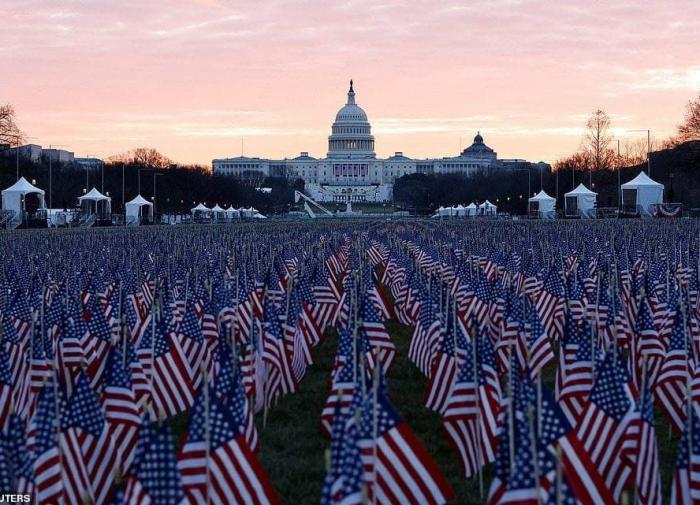America should atone for its own genocide
President Biden of the US was quick to label the killing of Armenians by the Turks during the First World War as "genocide', but America quietly and deftly avoids the mention of its own genocide of native Indians on the plains of North America during the Indian Wars of the 1860s. America's blatant hypocrisy should be noted.

During its westward expansion, the Wild West exploded into violence as Americans headed across the plains from St. Louis to California and regions of the northwest. And, when native people dared to challenge expansion into their territory, and fought back to hold onto their lands — which had been theirs for a thousand years — Americans simply looked upon them as a "nuisance' to be disposed of.
Using Stone Age weaponry — bows, arrows and spears — Indians were no match for Americans with modern, repeating rifles, cannons, and a malevolent determination to exterminate them in "quick time'. As an impediment to waves of immigrants moving west, Native Americans were simply overwhelmed by firepower and the savagery of American cavalry units which had no qualms about killing them in droves and driving them off their land.
In newspapers of the day, Native Indians were portrayed as savages who scalped their victims, but anyone who has studied the history of American Indians knows that they never scalped their victims when one tribe warred against another before white men arrived; they simply struck them with sticks and clubs and "counted coup'.
Scalping victims was an American invention used when they killed Indians as they advanced over the Western Plains, and kept scalps as trophies. Frontiersmen often scalped dead Indians and, later, Indians responded in kind. Native Indians were then depicted as barbaric savages for "scalping', which Americans themselves had initiated.
In the 1930s, 40s and 50s, hundreds of Hollywood western, action movies portrayed Native Indians as brutal, savage people, and as "bad guys'. Of course, American cavalry with their modern weapons were always presented as "good guys' who killed savages. But, in real life, it was the reverse — Americans were the barbarians, interlopers, and savages who killed without mercy.
Young movie-goers of the day were indoctrinated by these movies and saw Native peoples as "bad' persons who were unworthy of respect and, later, treated them as second-class citizens. This image still prevails in Western minds today; hence, the social disarray prevalent in America as a backlash to their past (America's genocide) builds to a crescendo.
The Indian Wars continued until Native Americans were killed by the thousands protecting their lands, their families, and their way of life from the encroachment of "white savages' from the East who sought their complete removal. The mantra of the day was: "the only good Indian is a dead Indian'. Americans treated them like vermin and killed them almost as quickly as the 70 million buffalo which roamed the western plains in the 1600s and 1700s, until 1890 when there were only 1000 buffalo left.
Finally, when Native Indians were exhausted, defeated, and most had surrendered, their land was confiscated, divided up, and sold to the highest bidder — most often to cattle ranchers who fenced off their "property'. For the previous 1000 years, native people had roamed freely on unfenced territory, and natural, physical boundaries between tribes were recognized and respected.
The defeated natives were then placed on "Reservations' - small patches of land — where they were supposed to live and follow the laws and restrictions of white Americans; the laws and rules by which native peoples had abided for a thousand years were suddenly nullified. On these poor-quality lands, Indians were expected to eke-out a living which, in most cases, was impossible. Americans then branded them as "lazy' and "useless'.
In 1970, the Hollywood film, "Little Big Man' outlined, for the first time, the truth of the Indian Wars. This film was later followed by others which examined the savage, brutal treatment, and dastardly deeds, which America committed while pursuing its dream of nationhood from Atlantic to Pacific.
And, if ever there was justice for America's atrocities against Native Indians of present-day United States, it occurred in late June, 1876 (Battle of the Little Bighorn) where 6000 Sioux Indians, drew General George Armstrong Custer into a trap, surrounded his regiment on Last Stand Hill, and killed them all. This was their revenge for decades of savagery and the barbarous genocide Americans had committed against them.
This was the last act of defiance by American Indians but it was eventually followed by America's final savagery, and vengeance for Custer, at Wounded Knee, South Dakota, where 300 unarmed, native Indians (men, women, children, and babes-in-arms) were slaughtered without mercy in late December, 1890.
In 160 years since America's genocide of its own native peoples, it has neither acknowledged its crime nor atoned for its reprehensible actions and, even now, considers itself both righteous and pious.
Today, America portrays itself as a kind, gentle people always willing to help others, but anyone who studies America's true history knows otherwise. So, when America points out a genocide which occurred over 100 years ago — but fails to mention its own moral turpitudes — we can be assured that it expects some direct benefits from such a pronouncement.
And, creating regional tensions, divisions, mistrust, animosities, and tearing apart long-standing, Turkish-Russian political ties appear to be a good bet.
Subscribe to Pravda.Ru Telegram channel, Facebook, RSS!


